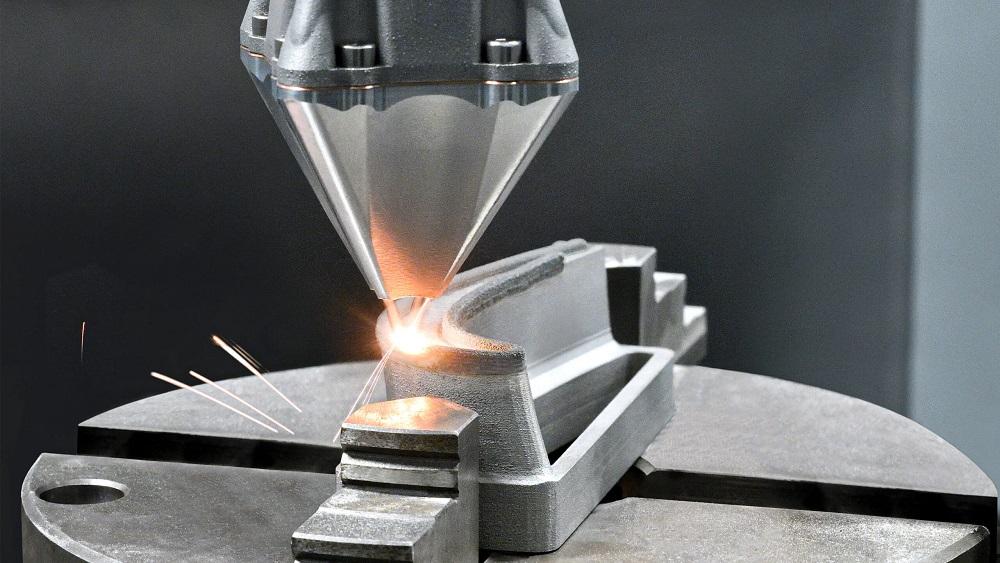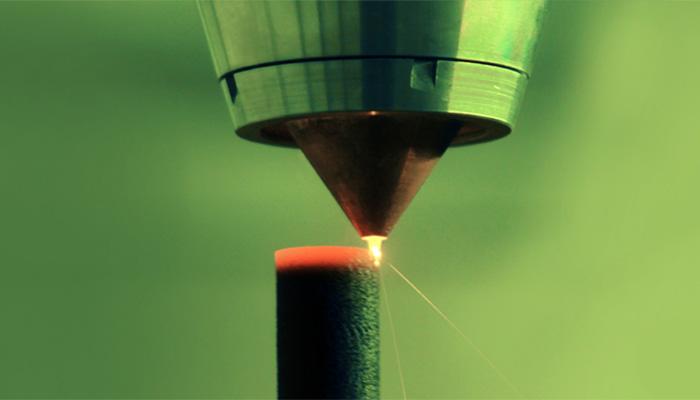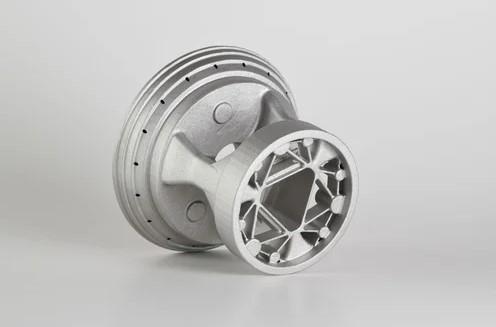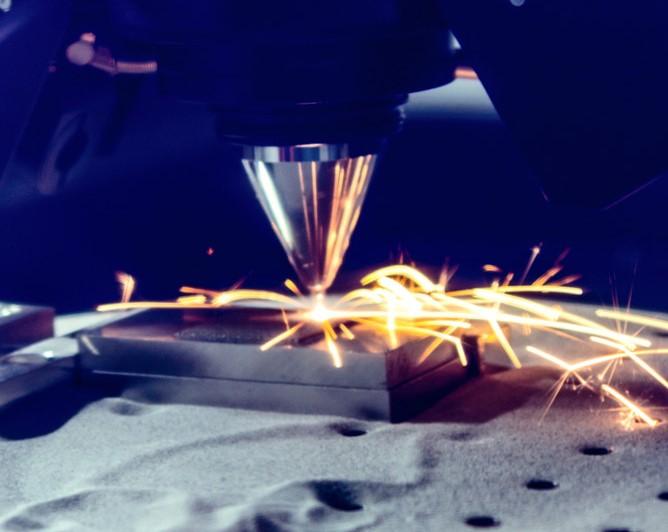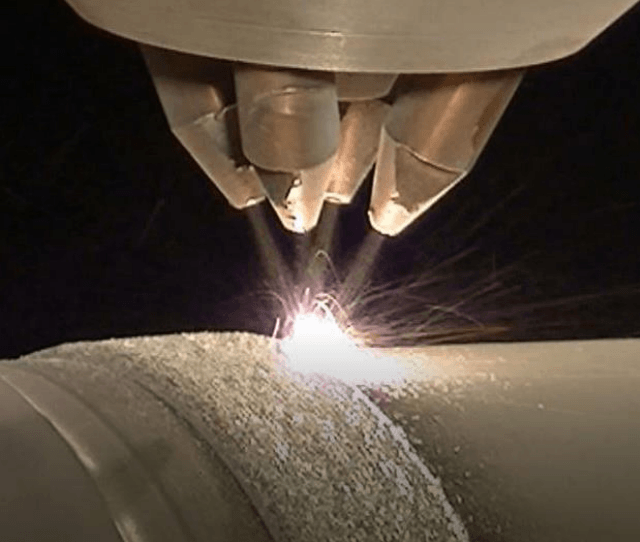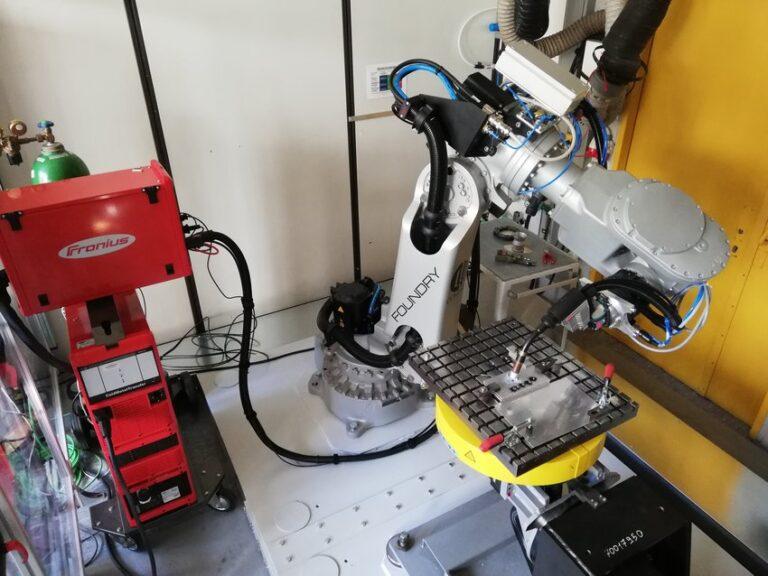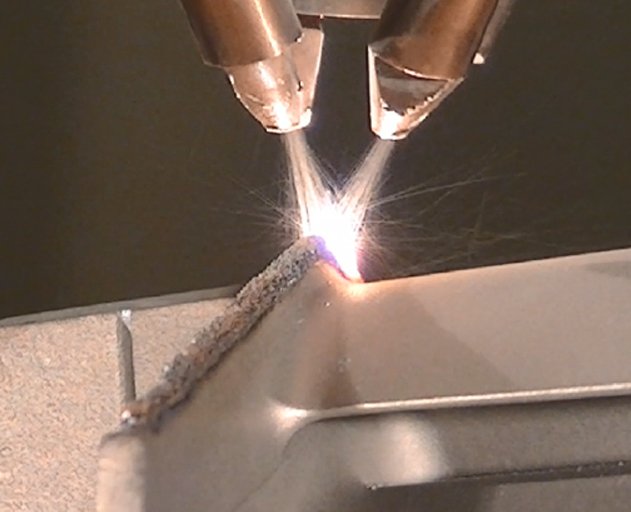Introduction to Directed Energy Deposition (DED) Technology
Using Direct Energy Deposition Equipment, manufacturers can precisely deposit material using a focused energy source, creating complex parts and structures with high precision and speed. This innovative technology has gained popularity in recent years and is a type of additive manufacturing process.
In this post, we will provide an introduction to DED technology and its various applications. We will also explore the factors to consider when choosing the right DED equipment for your manufacturing needs.
As discussed in previous posts such as “Overview of Directed Energy Deposition Process,” “Directed Energy Deposition, The A-Z Guide,” and “A Comprehensive Guide to Direct Energy Deposition: Understanding the Basics,” DED technology involves the use of a focused energy source, such as a laser or electron beam, to melt and deposit material onto a substrate. Typically, the operator feeds the material in the form of wire or powder into the system. The computer controls the deposition process to create precise geometries and structures.
The choice of DED equipment is critical to the success of the manufacturing process. Consider factors when choosing equipment: material compatibility, part size and complexity, production volume, budget, and support.
There are several types of DED equipment available, including powder-fed systems, wire-fed systems, laser-based systems, and electron-beam-based systems. Each type of equipment has its own advantages and limitations, and the choice will depend on the specific manufacturing requirements.
In conclusion, this post has provided an introduction to DED technology and its applications. We have also explored the factors to consider when choosing the right DED equipment for your manufacturing needs. Our post is a resource. It helps to learn about directed energy deposition. It also helps to choose the right equipment.
A brief overview of DED Technology
DED uses energy to deposit material onto the substrate. Industries use it for complex parts with precision. Aerospace, automotive, and medical industries are among the users.
DED tech melts and deposits material using focused energy. Laser or electron beams serve as the energy source. Feeding can be in the form of wire or powder. The computer controls the deposition process, enabling the creation of precise geometries and structures.
The process of DED technology involves several steps. First, the material is loaded into the feed mechanism of the DED equipment. Material is fed into the deposition area. Energy source melts the material. Material is deposited onto the substrate. The deposition process continues until the desired geometry is achieved.
DED technology offers high precision and speed for creating parts and structures. This technology also allows for the use of a wide range of materials, including metals, polymers, and ceramics.
In conclusion, DED technology is a powerful additive manufacturing process that has applications in a variety of industries. Its ability to create complex parts and structures with high precision and speed makes it a popular choice for many manufacturing applications.
Advantages and limitations of DED compared to other additive manufacturing techniques
Advantages and Limitations of DED Compared to Other Additive Manufacturing Techniques
Directed Energy Deposition (DED) technology offers several advantages over other additive manufacturing techniques. One of the primary advantages is the ability to create parts and structures with high precision and speed. This technology also allows for the use of a wide range of materials, including metals, polymers, and ceramics.
Other advantages of DED technology include the ability to create complex geometries and structures that are difficult or impossible to produce using traditional manufacturing techniques. Additionally, DED technology enables the repair and refurbishment of damaged or worn parts, thereby reducing the need for costly replacements.
However, there are also limitations to DED technology. One of the primary limitations is the cost of equipment and maintenance. DED equipment can be expensive to purchase and maintain, making it less accessible to smaller manufacturers or businesses with limited budgets.
Another limitation of DED technology is the potential for defects in the finished product. Due to the nature of the deposition process, there is a risk of porosity, cracking, or other defects in the final part. Additionally, DED technology may not be suitable for all types of materials or applications.
DED has advantages: high precision, speed, complex geometries, and material range. Limitations include equipment cost, maintenance, and potential defects in finished products. Consider these factors when selecting a manufacturing technique.
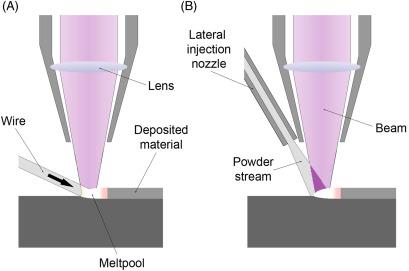
Factors to Consider When Choosing DED Equipment
Directed Energy Deposition (DED) technology offers many advantages for manufacturers, but choosing the right equipment can be a daunting task. Factors to consider when selecting DED equipment:
- Material compatibility
- Part size and complexity
- Production volume and throughput
- Budget considerations
- Available support and training
Material compatibility
Material compatibility is an important consideration when selecting DED equipment. Some equipment may only be compatible with certain materials, while others may be able to process a wider range of materials. It’s essential to choose equipment that can handle the materials needed for your specific manufacturing needs.
Part size and complexity
When selecting DED equipment, you should also consider the size and complexity of the part. Certain equipment may better suit larger or more complex parts, whereas other equipment may better suit smaller, simpler parts. It’s important to choose equipment that can handle the size and complexity of the parts you need to produce.
Production volume and throughput
Production volume and throughput are also crucial considerations. Some DED equipment might suit low-volume production better, and some others might suit high-volume production better. It’s important to choose equipment that can meet your production needs and maintain consistent quality and performance.
Budget considerations
Budget considerations are also important when selecting DED equipment. Equipment options have varying prices. Choose equipment within budget. Do not sacrifice quality or performance.
Available support and training
Finally, available support and training should be considered when selecting DED equipment. Choosing a reputable manufacturer for DED equipment is important. Adequate training and support should be offered. Proper use and maintenance are necessary.
Choosing the right DED equipment requires careful consideration. Factors to consider include material compatibility, part size, and complexity. Production volume and throughput should also be taken into account. Budget considerations and available support and training are also important. By carefully weighing these factors, manufacturers can select the right equipment to meet their unique manufacturing needs.
Types of DED Equipment
Directed Energy Deposition (DED) technology encompasses a variety of equipment types, each designed to meet specific manufacturing needs. The most common types of DED equipment include laser-based systems, electron beam systems, and wire arc systems.
Laser-based systems use a high-powered laser to melt and fuse metal powders, creating precise and complex parts. These systems are ideal for creating parts with high accuracy and speed.
Electron beam systems use a beam of electrons to melt and fuse metal powders, creating dense and strong parts. These systems are ideal for creating parts with high strength and durability.
Wire arc systems use a wire electrode and an electric arc to melt and fuse metal, creating parts with high deposition rates and low material waste. These systems are ideal for creating large parts and repairing existing components.
Other DED equipment types include plasma arc systems, powder nozzle systems, and blown powder systems. Each equipment type has its own advantages and limitations, and it’s important to choose the right type for your specific manufacturing needs.
In conclusion, DED technology offers a range of equipment types to meet specific manufacturing needs. By understanding the advantages and limitations of each equipment type, manufacturers can select the right DED equipment to produce precise and complex parts with high speed and accuracy.
Powder-fed systems
Powder-fed systems are known as DED equipment that use a nozzle to deposit metal powders onto a workpiece. The equipment feeds powders through a hopper or cartridge. Laser or electron beam can preheat or melt them in situ. Powders allow greater flexibility in material selection. They can enhance the quality of the final part. Systems require careful control of powder feed rate, temperature, and velocity. This ensures proper melting and fusion of deposited material.
Additionally, achieving desired material properties may require performing post-processing steps such as sintering or hot isostatic pressing. Overall, powder-fed DED systems offer a versatile and efficient method for additive manufacturing, but require careful attention to material handling and process parameters to ensure consistent and reliable results.
Wire-fed systems
Directed Energy Deposition (DED) equipment uses metal wires as feedstock material in wire-fed systems. The wire is fed into the system through a wire feeder and melted using a high-energy heat source such as a laser or an electron beam. The melted wire is then deposited onto the workpiece to build up the desired part or structure. Wire-fed systems are particularly useful for repairing or adding material to existing components. They also offer high deposition rates and can work with a variety of materials, including metals and alloys. However, wire selection, wire feeding, and wire melting can be complex and require precise control to ensure quality and consistency.
Laser-based systems
Laser-based systems in Directed Energy Deposition (DED) technology use a focused laser beam to melt and deposit material. We direct the laser beam onto the surface of the workpiece, and it melts and deposits material layer by layer to create the desired part. We can precisely control the laser beam to create parts with high accuracy and resolution. The advantage of laser-based systems is their ability to work with a wide range of materials including metals, polymers, and ceramics. These systems have limitations, including the equipment’s high cost and the limited size of the parts that can be produced. Aerospace, automotive, and medical industries commonly use laser-based DED systems to produce small to medium-sized parts with high precision and quality.
Electron beam-based systems
Electron beam-based systems use electron beams to melt and deposit metal in Directed Energy Deposition (DED) equipment. These systems use a high-energy electron beam to melt the material and deposit it onto the workpiece. This process is similar to laser-based systems but uses an electron beam instead of a laser. Using magnetic fields precisely focuses and directs the electron beam, enabling high precision and control over the deposition process. One advantage of electron beam-based systems is that they can work with a wider range of materials than other DED technologies. However, the equipment can be expensive and requires specialized training to operate.
plasma arc systems
Plasma arc systems are a type of Directed Energy Deposition Equipment that uses a high-energy plasma arc to melt and deposit material onto a workpiece. Passing a gas such as argon or nitrogen through an electric arc ionizes the gas and creates a plasma, which generates the plasma arc. The plasma arc melts the material to be deposited by reaching temperatures up to 20,000°C. This process allows for high deposition rates and the ability to deposit a wide range of materials. However, plasma arc systems require precise control of the plasma arc to ensure proper melting and deposition of the material, and can also produce a high amount of heat and spatter.
Powder nozzle systems
Powder nozzle systems are a type of Directed Energy Deposition Equipment that uses a nozzle to inject metal powders into the melt pool created by the energy source. The powders are fed through the nozzle using a carrier gas and melted by the energy source to create the desired shape. This system offers precise control over the powder flow rate and placement, resulting in higher accuracy and quality. Powder nozzle systems are similar to powder-fed systems, but they use a different method of powder delivery. In powder-fed systems, the powder is typically fed directly into the melt pool using a hopper, while in powder nozzle systems, the powder is delivered through a nozzle.
Blown powder systems
Blown powder systems, also known as powder jet systems, are a type of Directed Energy Deposition Equipment that use a high-velocity stream of gas to transport and deposit powdered material onto a substrate. The powder material is typically stored in a hopper and fed into the gas stream through a nozzle, where it is accelerated and deposited onto the substrate.
The main difference between blown powder systems and powder nozzle systems is the method of powder delivery. In powder nozzle systems, the powder is delivered through a nozzle directly into the melt pool, while in blown powder systems, the powder is delivered by a gas stream that carries it to the melt pool.
Blown powder systems have some advantages over powder nozzle systems. They are able to deposit materials at higher rates and can cover a larger area without the need for multiple passes. However, they may have lower power efficiency and can produce less dense parts compared to powder nozzle systems.
Blown powder systems are also different from powder feeder systems, which use a screw or piston to feed powder into the melt pool. Powder feeder systems are typically used in laser-based systems and may have different characteristics compared to blown powder and powder nozzle systems.
Conclusion and Recommendations
In conclusion, selecting the right Directed Energy Deposition Equipment (DED) is a critical decision that can impact the quality and efficiency of your manufacturing process. Consider your specific application, material type, and budget when choosing the appropriate DED system. It’s important to evaluate the capabilities and limitations of each system, such as the powder and wire feed systems, laser-based systems, electron beam-based systems, plasma arc systems, and blown powder systems.
Final thoughts on selecting the right DED equipment
For the best results, we recommend working with a trusted supplier who can help you choose the most suitable DED equipment for your needs. It’s also essential to have a team with specialized knowledge and experience in DED technology to operate the system effectively and maximize its potential.
Recommendations for further reading and research
For further reading and research, we recommend exploring books and journals on additive manufacturing and DED technology, such as the book “Additive Manufacturing Technologies” by Ian Gibson. Keeping up to date with the latest advancements in DED technology can help you stay ahead in the ever-evolving manufacturing industry.
How to choose the right DED equipment for a specific application?
- Define the Application
Clearly define the specific application for which the DED equipment will be used, including the material type, part geometry, and required quality standards.
- Consider the DED Process
Determine which DED process will be most suitable for the application, taking into account factors such as material deposition rate, heat input, and the size and complexity of the parts being produced.
- Evaluate Available Equipment
Research and compare available DED equipment options, considering factors such as the size of the equipment, its capabilities and limitations, and the level of automation offered.
- Assess Support and Training
Consider the availability of support and training from the manufacturer or supplier of the chosen DED equipment, including software and hardware support, as well as training for operators and maintenance personnel.
- Calculate the Cost of Ownership
Determine the total cost of ownership of the selected DED equipment, including equipment purchase or lease costs, maintenance and repair costs, and any additional costs associated with software and hardware updates.
- Select and Purchase Equipment
Based on the results of the previous steps, select the most suitable DED equipment for the application and purchase or lease it from a reputable supplier or manufacturer.
- Install and Test Equipment
Properly install and test the DED equipment to ensure it is functioning correctly and capable of producing high-quality parts.
- Train Operators and Maintenance Personnel
Provide training for operators and maintenance personnel on the proper use and maintenance of the DED equipment to ensure optimal performance and longevity.
FAQs
DED equipment can work with a variety of materials, including metals, plastics, ceramics, and composites. The specific materials that can be used may vary based on the type of DED equipment being used and the application.
The precision of DED equipment can vary based on a number of factors, such as the specific type of equipment being used, the materials being used, and the complexity of the part being produced. In general, however, DED equipment is capable of producing parts with high levels of accuracy and repeatability.
Yes, DED equipment can be used for small-scale production runs, as well as for prototyping and research and development purposes. However, for larger production runs, it may be more efficient to use other manufacturing methods.
The time it takes to set up and operate DED equipment can vary based on the specific type of equipment being used and the complexity of the part being produced. However, with proper training and experience, operators can typically set up and run DED equipment in a matter of hours.
When using DED equipment, it is important to follow all recommended safety guidelines, such as wearing appropriate personal protective equipment (PPE), ensuring proper ventilation in the workspace, and following established protocols for handling and storing materials. It is also important to receive proper training on the specific equipment being used and to stay aware of any potential hazards associated with the process.

